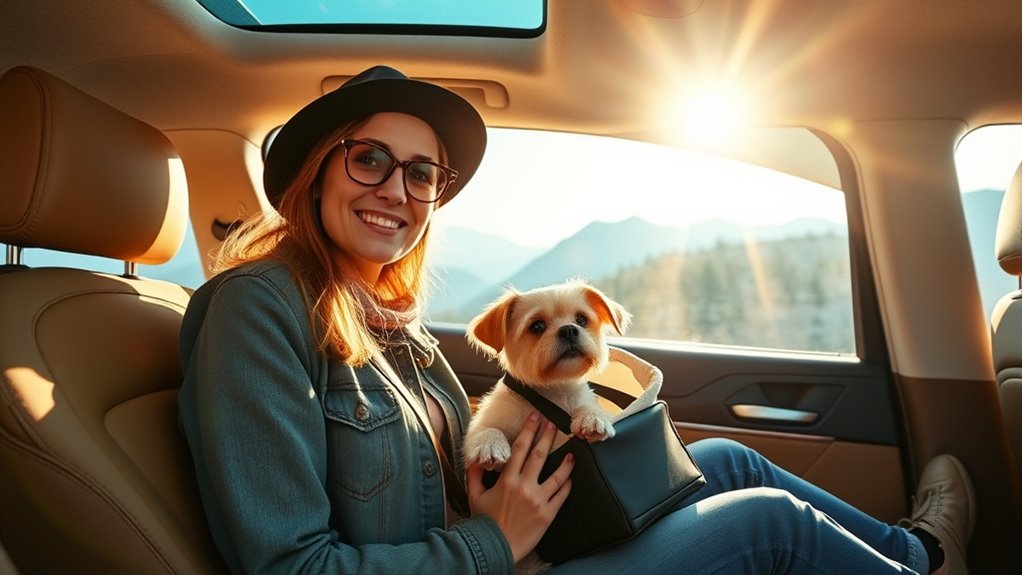To make traveling with pets stress-free, start by preparing your pet early with training and familiar items like toys or blankets. Pack all essentials, including food, medications, and documents. Choose a comfortable, well-ventilated mode of transport and secure your pet safely. Keep a calm environment, offer regular breaks, and stay positive throughout the trip. If you want to learn more about smooth travel tips, keep exploring how to create a peaceful journey for your furry friend.
Key Takeaways
- Prepare your pet with early training, current vaccinations, and familiar items to ensure comfort and safety during travel.
- Create a calm environment using familiar toys, routine, and soothing techniques to reduce anxiety.
- Ensure proper restraints and ventilation, and monitor hydration and temperature for your pet’s safety.
- Plan regular breaks for hydration, comfort, and behavior management, avoiding leaving your pet unattended in extreme conditions.
- Maintain a positive attitude and gentle approach to make the journey stress-free for your pet.
Prepare Your Pet for the Journey
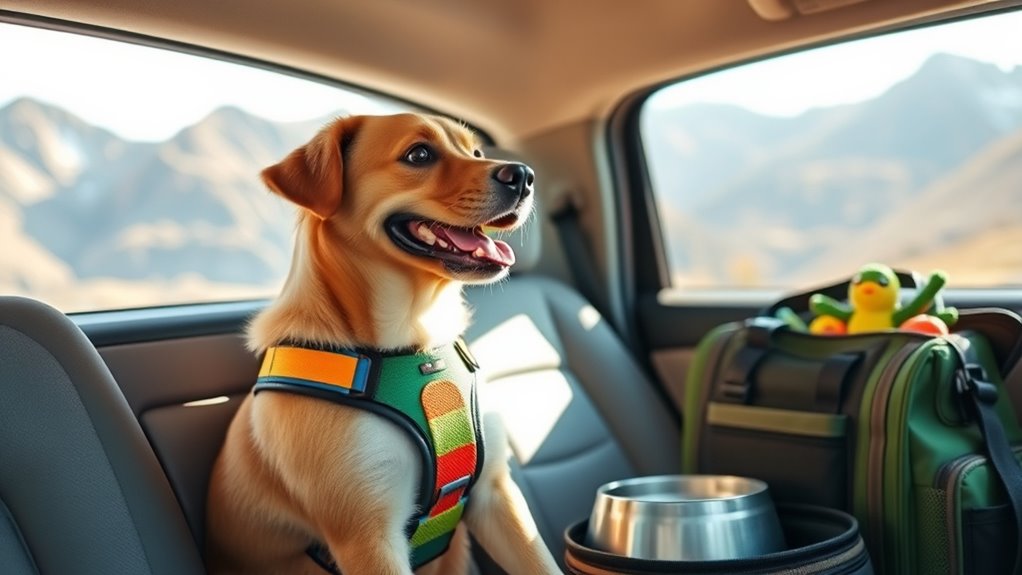
To guarantee your pet remains comfortable and stress-free during travel, start preparing well in advance. Begin with pet training to help your furry friend get used to their crate or carrier, making the journey smoother. Gradually introduce them to the travel environment, encouraging calm behavior. Schedule a vet checkup before your trip to ensure your pet is healthy and up-to-date on vaccinations. A vet can also advise you on any necessary medications or precautions for travel. Reinforcing positive associations with travel gear and routines helps reduce anxiety. Understanding emotional support techniques can also help your pet cope better with the stress of travel. By starting early, you give your pet time to adjust, making the experience less stressful for both of you. Proper preparation creates a confident, relaxed pet ready for the adventure ahead.
Pack Essential Items for Your Pet

Packing essential items for your pet guarantees their comfort and safety throughout the journey. Bring along their favorite food and enough supplies to meet their dietary needs, especially if traveling for several days. Include familiar pet grooming items like brushes or wipes to keep them clean and comfortable. Don’t forget a leash, harness, and a secure carrier for safety during transit. Carry a few of their favorite toys to provide comfort and reduce stress. Having familiar items helps your pet feel secure in unfamiliar surroundings. Make sure to pack any medications, health records, and a first aid kit tailored for your pet. Being well-prepared ensures your furry friend stays comfortable, healthy, and happy throughout your trip.
Choose the Right Transportation Method
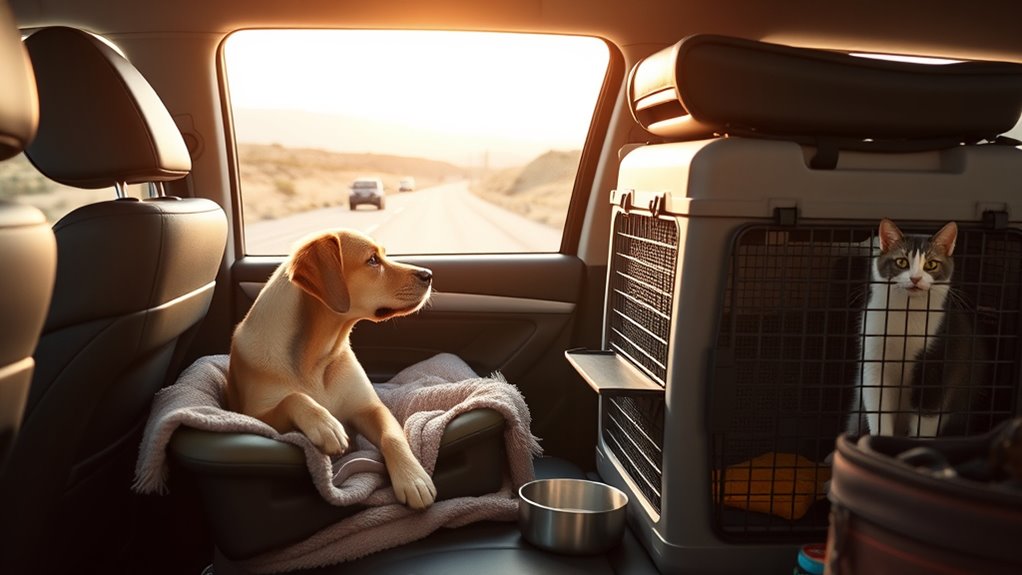
When selecting a transportation method, consider your pet’s size and comfort to guarantee a smooth trip. If you’re flying, check airline policies and prepare for security procedures to keep your pet safe. For road trips, choose a vehicle that provides enough space and proper ventilation for your furry companion. Using an eye patch can help reduce stress and protect your pet’s eyes from harsh lights during travel.
Vehicle Selection Tips
Choosing the right vehicle is crucial for a smooth and safe trip with your pet. You want a vehicle that prioritizes vehicle safety and pet comfort. An SUV or spacious hatchback often provides enough room for your pet to move comfortably and securely. Consider a vehicle with climate controls to keep your pet cool or warm throughout the journey. Cramped cars can cause stress and discomfort, so avoid smaller vehicles if possible. Use a well-ventilated crate or harness designed for travel to keep your pet safe and secure. Make sure there’s enough space for water, bedding, and toys to help your pet stay relaxed. Additionally, paying attention to interior layout can improve your pet’s comfort during the trip. Ultimately, selecting a vehicle that balances safety features and comfort will ensure a happier, less stressful trip for both of you.
Air Travel Precautions
Air travel can be a convenient way to reach your destination with your pet, but it requires careful planning to guarantee their safety and comfort. Start by researching pet airline policies to understand restrictions, fees, and crate requirements. Confirm whether your pet can fly in the cabin or must travel as cargo. Ensure you have all necessary travel documentation, such as health certificates and vaccination records, well in advance. Double-check airline regulations on crate size, labeling, and check-in procedures. Preparing these details ahead of time helps prevent delays or surprises at the airport. Also, consider your pet’s comfort by choosing direct flights and familiarizing them with their crate before travel. Proper planning ensures a smoother, less stressful journey for both you and your furry companion. Additionally, storing essential oils properly in your travel kit can help manage stress and keep your pet comfortable during the trip.
Keep Your Pet Comfortable During Travel
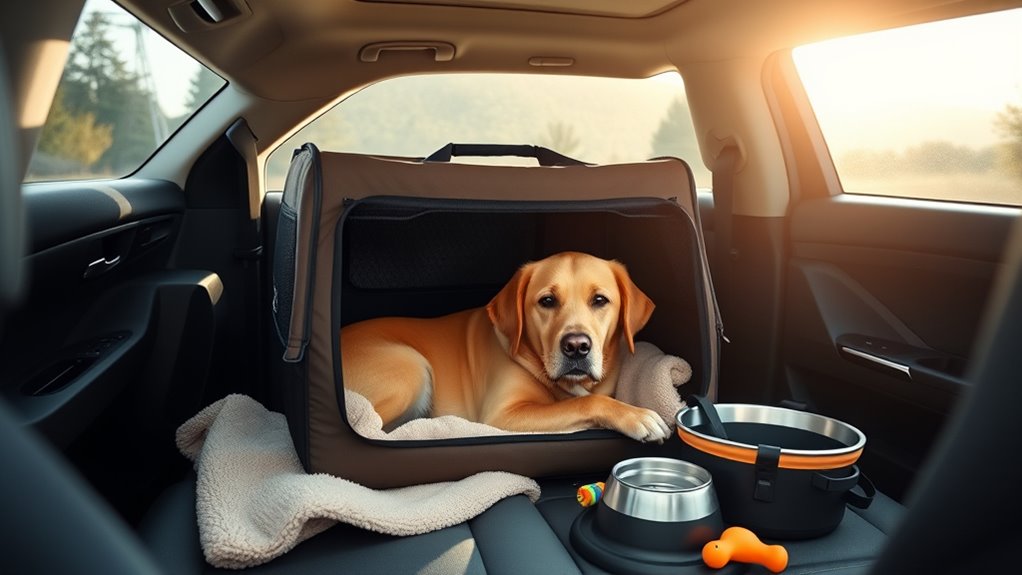
Ensuring your pet stays comfortable during travel can make the journey more enjoyable for both of you. To reduce pet anxiety, create a calm environment by maintaining a steady, gentle pace and speaking softly. Focus on carrier comfort by choosing the right size and lining it with familiar blankets or toys, which help your pet feel secure. Make sure the carrier is well-ventilated and placed in a stable spot where your pet won’t be jostled too much. During stops, check that your pet remains comfortable and isn’t overheating or cold. Providing water and avoiding sudden movements also help keep your pet calm. Additionally, selecting a vacuum with a HEPA filter can help maintain clean air in your home, reducing allergens that may affect your pet’s respiratory health. By prioritizing their comfort, you’ll ease their stress and make travel a smoother, more pleasant experience.
Follow Safety Guidelines and Regulations
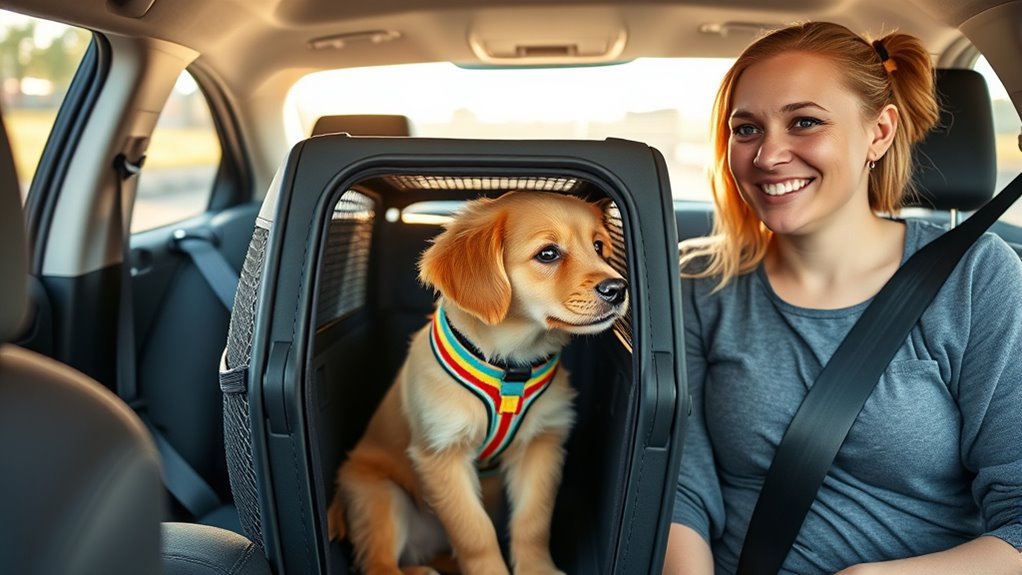
To keep your pet safe during travel, it’s vital to follow all relevant safety guidelines and regulations. Make sure your pet’s vaccination requirements are up to date, as many places require proof of vaccinations to prevent the spread of disease. Additionally, adhere to leash regulations in public areas—using a secure leash helps prevent your pet from escaping or getting injured. Always carry necessary documentation, like vaccination records, in case authorities ask for verification. Respect local rules about containment and control, especially in unfamiliar environments. Being aware of local regulations can help you avoid unintentional violations. Following these safety guidelines not only protects your pet but also ensures a smooth journey for everyone. Staying informed and compliant minimizes risks and makes traveling a safer, more enjoyable experience for your furry friend.
Plan for Breaks and Rest Stops

Planning for regular breaks and rest stops during your trip helps keep your pet comfortable and stress-free. Schedule snack breaks to give your pet a chance to hydrate and stretch their legs. Look for scenic routes that offer safe, open areas for walks and exploration, making the stops enjoyable for both of you. Keep your pet on a leash or in a secure carrier during these breaks to prevent accidents or escapes. Bringing familiar toys or bedding can make these pauses more comforting. Remember, frequent stops reduce anxiety and prevent discomfort from long periods of confinement. Incorporating automation technologies into your travel plan can help coordinate rest stops more efficiently, ensuring a smoother journey for you and your pet.
Stay Calm and Positive Throughout the Trip
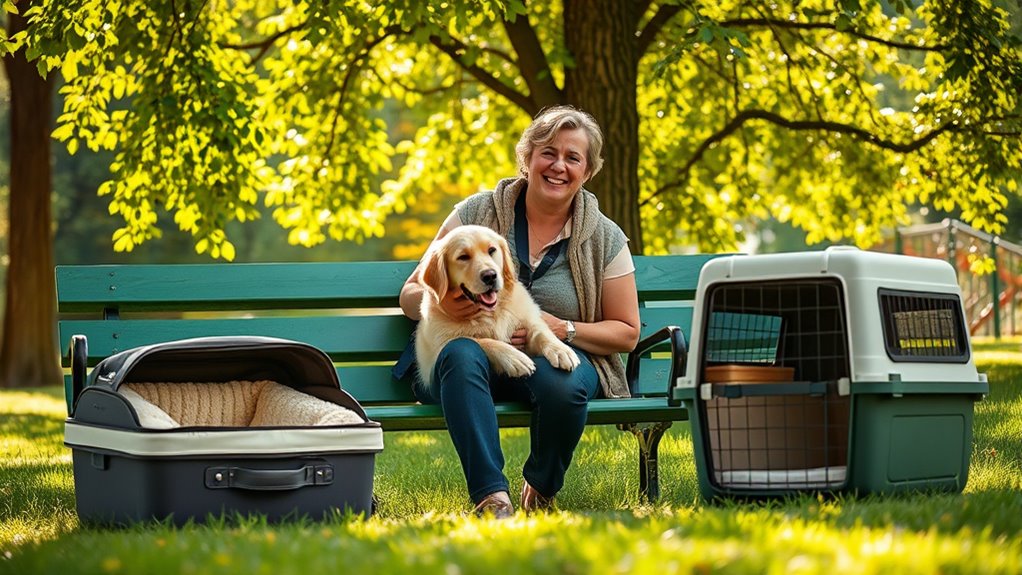
Staying calm and positive during your trip can make a big difference in how your pet handles the journey. Pet anxiety often increases when you’re stressed, so your mood directly impacts theirs. Use calming techniques like gentle voice, slow movements, or soft music to soothe your pet. Keep a relaxed demeanor, as animals pick up on your energy. Bring familiar items such as their favorite blanket or toy to provide comfort. Take deep breaths if you start feeling anxious, and remind yourself that staying composed helps reduce your pet’s stress. Remember, your calm attitude encourages your pet to stay relaxed, making the trip smoother for both of you. A positive outlook can turn travel into a more enjoyable experience. Fostering kindness and positive change can help you stay centered and create a more peaceful environment during your trip.
Frequently Asked Questions
How Can I Help My Pet Overcome Travel Anxiety?
You might think travel anxiety is unavoidable, but you can help your pet feel calmer. Start with pet grooming to reduce discomfort and make them feel secure. Use travel accessories like familiar blankets or toys to create a sense of familiarity. Before the trip, practice short rides to build positive associations. By preparing in advance, you help your pet overcome travel anxiety and enjoy the journey with less stress.
Are There Specific Health Concerns for Pets During Long Trips?
During long trips, you should watch out for health concerns like pet dehydration and motion sickness. Make certain your pet stays hydrated by offering water regularly and taking breaks for drinks. Watch for signs of motion sickness, such as vomiting or drooling, and consider consulting your vet about remedies. Keeping your pet comfortable and well-hydrated helps prevent health issues and makes the journey smoother for both of you.
What Are the Best Ways to Introduce Pets to New Environments?
You should start by gradually introducing your pet to new environments through familiarization routines, like short visits or carrying familiar items. When you arrive at pet-friendly accommodations, give your pet time to explore and settle. Keep routines consistent, and offer treats or toys to ease anxiety. This approach helps your pet adapt comfortably, making the progression smoother and reducing stress during your travels.
How Do I Handle Emergencies or Health Issues While Traveling?
Did you know 70% of pet travelers face emergencies? To handle health issues on the go, always carry pet travel gear like a first aid kit and guarantee your pet’s vaccinations are up-to-date. Keep an emergency contact prep list accessible, including your vet’s info and nearby animal hospitals. Staying prepared helps you respond swiftly, keeping your pet safe and calm during unexpected situations.
Can Pets Travel With Special Dietary Needs or Medications?
When traveling with pets that have special diets or require medication management, you need to plan ahead. Bring enough special food and medications for the entire trip, plus a little extra in case of delays. Keep medications in their original packaging and carry a veterinarian’s note if needed. Consult your vet beforehand to guarantee your pet’s health needs are fully met and to get tips for managing their diet during travel.
Conclusion
Traveling with your pet is like steering a small boat through unpredictable waters—you need preparation, patience, and calmness. When I took my dog on a long road trip, a little planning turned chaos into smooth sailing. Remember, staying relaxed and prepared helps your pet feel secure, making the journey enjoyable for both of you. With these tips, your adventure can be as memorable and stress-free as a peaceful voyage across calm seas.
